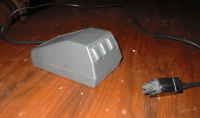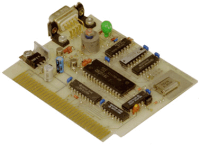 This
article is a free translation of the article published in the hungarian
Enterpress magazine. (3rd year No2. at 1992. march-april)
This
article is a free translation of the article published in the hungarian
Enterpress magazine. (3rd year No2. at 1992. march-april)Mouse
 This
article is a free translation of the article published in the hungarian
Enterpress magazine. (3rd year No2. at 1992. march-april)
This
article is a free translation of the article published in the hungarian
Enterpress magazine. (3rd year No2. at 1992. march-april)
Lets talk about the mouse. Here is a bad mouse, for example the original Enterprise mouse, which is widely callad as "rat". Any of the PC mouse are better than this large one, and the PC mouses are muc more cheaper. But the only problem with the PC mouses, there is no connector for them.
To solve this problem, there is now a serial line interface card, which allows to connect the PC mouse and the Enterprise together.
Yes, there is serail port for the Enterprise, and it is a logical question, to ask, why not use that port for it.
The answer is yes, it is possible, but this serial port is software driven, the serial data is converted by the CPU, so not a useful option. (We have tried it, so forget the serail port for this function.)
The card was born, and now you can see it the attached drawing.
 The
main part of this device is the Intel 8251A (U1). U2 interfaces the data lines
to the computer, and U6 and U7 interfaces the serial inputs and outputs to the
outer world. The numbers are standard CANNON connector numbers, the texts over
them are the RS-232 line names.
The
main part of this device is the Intel 8251A (U1). U2 interfaces the data lines
to the computer, and U6 and U7 interfaces the serial inputs and outputs to the
outer world. The numbers are standard CANNON connector numbers, the texts over
them are the RS-232 line names.
(...)
The remaining parts of the U4 translates levels. It is remarkable tho check the U4D - D1 lines, throug this lines the U1 can give interrupt to the CPU, so, between to bytes, there is free processor time.
There is a voltage level stabilisator (U8) on the drawing, which gives +5 V for the ICs, but there is not on the drawing (on the card of-course assembled) the part of the circuit, which produce the +/- 12 V. This -12 V needed for the mouse, but we not drawed here because the drawing is too complex with it.
Now, we know, how the card works, lets see the other side, the mouses.
The most parts of the PC mouses are connected to the computer through the serial line. Ther is two widely spreaded group, the Microsoft-compatible ("two button") and the Mouse Systems compatible ("three button"). For the simplicity, we are only taking closer look with the second group.
(...)
At first the mouse needs power, which is comming from the -DTR line (-12 V). When we move the mouse, (...) the mouse send the dislocation, and the mouse button states to the computer (five bytes ).
Detailed: The first three bits of the first byte is the status of the buttons inverted. The summ of the second and fourth bytes are the X direction moving, the summ of the third and fifth bytes are the Y direction moving (signed value)
P.S.: If somebody interested in this thing, it is avaible for order from the address at the end of the article. There is a software for the adapter from the Devilsoft. (...)
(This address was valid in 1992, maybe it is not valid now - the translator)
M. Gy. Hard-Soft
1029 Bp., Zsíroshegyi út 110.
Enterpress III. évfolyam 2. szám 1992. március-április